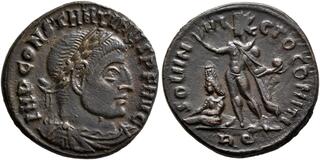| Leu Numismatik AG > Web Auction 28 | Auction date: 9 December 2023 |
| Lot number: 4662 Price realized: 1,900 CHF (Approx. 2,160 USD / 2,006 EUR) Note: Prices do not include buyer's fees. | Show similar lots on CoinArchives Find similar lots in upcoming auctions on |
| Lot description: Constantine I, 307/310-337. Follis (Bronze, 18 mm, 3.25 g, 6 h), Rome, 316-317. IMP CONSTANTINVS P F AVG Laureate, draped and cuirassed bust of Constantine I to right. Rev. SOLI IN-VI-CTO COMITI / R Q Sol, nude but for chlamys, standing front, head to left, raising his right hand in salute and holding globe in his left; to left at his feet, Tiridates III (or IV) seated left, wearing Armenian tiara. RIC -. Extremely rare and of great historical interest. A highly important piece with a Roman rendering of an Armenian king. The obverse a bit weak and with very minor weakness on the reverse, otherwise, good very fine. From the collection of Dr. L. Ramskold, formed since 1969. Rather than a regular captive, this fascinating piece shows a figure wearing an Armenian tiara on the reverse. W. Weiser (Zum Gründungsdatum der Armenischen Kirche. Eine Bronzemünze von Constantinus I. dem Grossen, geprägt im Herbst 314, während des Kibalesischen Krieges, in Rom, mit dem Bild des Königs Tiridates des Grossen von Armenien, in: Kölner Jahrbuch 43 (2010), p. 817-837) has argued that this figure is none other than the Armenian king himself. In the early 4th century, the Armenia was ruled by Tiridates III (or IV, depending on the counting), who was the first ruler in the world to convert his kingdom to Christianity. According to legend, the conversion occurred after the king had sought to marry a Christian nun, who spurned his advances and was tortured and executed along with her companions for the insult. Afterwards, the king was driven mad by divine intervention and only cured by Saint Gregory (the Illuminator), the later founder of the Armenian Church, prompting Tiridates' conversion. Curiously, the Armenian sources record a visit of the king and Saint Gregory to Constantine in Rome, though this visit was likely fictitious. Weiser argues that a smaller delegation carrying the king's portrait may rather have visited Rome, providing the example for the king's depiction on this fascinating issue. Of course, we must wonder why the king is placed in the same position as the captives normally are on this issue, especially if he was an ally of Rome. Roman ideology generally saw foreign rulers - with the exception of the Sassanid King of Kings - as subjected to the Empire's power, which was particularly poignant for Armenia, a region continually torn between Rome and Persia, and whose kings often ruled with the backing of either superpower. As such, the coin should perhaps not be seen as a celebration of the good relations between Constantine and Tiridates, but rather as an expression of Rome's claim to supremacy in the East. Starting price: 100 CHF |  |



